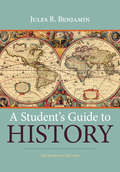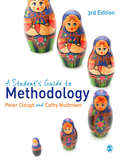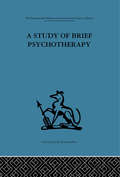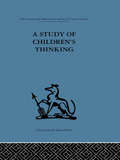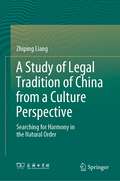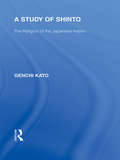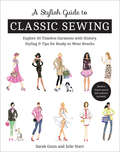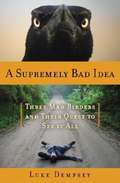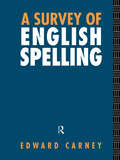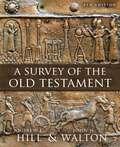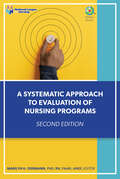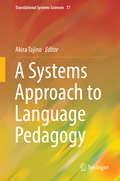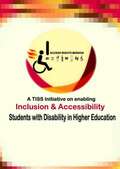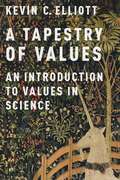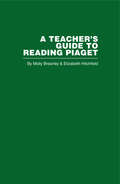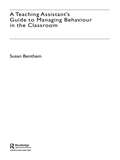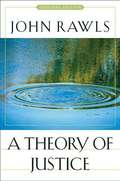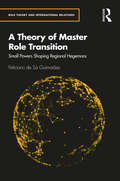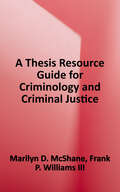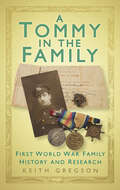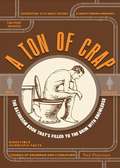- Table View
- List View
A Student’s Guide to History
by Jules BenjaminThis guide provides comprehensive coverage of the historian's research process - from formulating a research question to finding, evaluating, and working with sources of all types - written and nonwritten, in print and online. The writing process is explained thoroughly, and advice on creating a strong thesis and writing an effective paper culminate in a model student research paper. The appendixes point students to the most helpful research resources.
A Student′s Guide to Methodology: Justifying Enquiry
by Cathy Nutbrown Peter CloughThe Third Edition of this hugely popular text provides students with straightforward principles and frameworks for understanding methodology. Peter Clough and Cathy Nutbrown are adept at making methodology meaningful for beginners and more advanced readers alike. Their book clearly demonstrates how methodology impacts upon every stage of the research process, and gives readers all of the tools that they need to understand it. New to this edition are the following: - new boxes and guidance on research ethics in every chapter - more international examples and perspectives - up to date coverage of online research methods - more examples from real students - a new companion website, featuring Powerpoint slides for lecturers The authors take an applied approach and every chapter contains a variety of practical examples from real research. Readers are encouraged to reflect on their own practice at every step, meaning that the book remains extremely relevant throughout. It will be invaluable for all students who are doing a dissertation or taking a research methods module in education, the social sciences, business and health.
A Study of Brief Psychotherapy
by D. H. MalanTavistock Press was established as a co-operative venture between the Tavistock Institute and Routledge & Kegan Paul (RKP) in the 1950s to produce a series of major contributions across the social sciences. This volume is part of a 2001 reissue of a selection of those important works which have since gone out of print, or are difficult to locate. Published by Routledge, 112 volumes in total are being brought together under the name The International Behavioural and Social Sciences Library: Classics from the Tavistock Press. Reproduced here in facsimile, this volume was originally published in 1963 and is available individually. The collection is also available in a number of themed mini-sets of between 5 and 13 volumes, or as a complete collection.
A Study of Children's Thinking (International Behavioural And Social Sciences Ser. #Vol. 8)
by Margaret Donaldson Donald WithringtonTavistock Press was established as a co-operative venture between the Tavistock Institute and Routledge & Kegan Paul (RKP) in the 1950s to produce a series of major contributions across the social sciences. This volume is part of a 2001 reissue of a selection of those important works which have since gone out of print, or are difficult to locate. Published by Routledge, 112 volumes in total are being brought together under the name The International Behavioural and Social Sciences Library: Classics from the Tavistock Press. Reproduced here in facsimile, this volume was originally published in 1963 and is available individually. The collection is also available in a number of themed mini-sets of between 5 and 13 volumes, or as a complete collection.
A Study of Criminal Proceeding Conventions in Tang Dynasty
by Xi ChenThis book uses the monographic study of litigation subjects, prosecution, trial, and enforcement to reveal the formation, operation, and development of criminal proceeding conventions in the Tang Dynasty. It also outlines the combination, coordination, and interaction of rules, conventions, and ideas in the traditional Chinese legal system, and presents an overview of the evolution and development of traditional litigation in China. This book is intended mainly for scholars and graduate and undergraduate students in the fields of law and Chinese history.
A Study of Legal Tradition of China from a Culture Perspective: Searching for Harmony in the Natural Order
by Zhiping LiangProfessor Zhiping Liang offers a new understanding of Chinese legal tradition in this profoundly influential book. Unlike the available literature using the usual method of legal history research, this book attempts to illustrate ancient Chinese legal tradition through cultural interpretation. The author holds that both the concept and practice of law are meaningful cultural symbols. The law reveals not only the life pattern in a specific time and space but also the world of the mind of a specific group of people. Therefore, just as cultures have different types, laws embedded in different societies and cultures also have different characters and spirits. Believing that human experience is often condensed into concepts, categories, and classifications, the author begins his discussion with the analysis of relevant terms and then seeks to understand history by interpreting the interaction and interconnectedness of the words, ideas, and practices. Based on the same understanding, the author uses modern concepts reflectively and critically, consciously exploiting the differences between ancient and contemporary Chinese and Western concepts to achieve a more realistic understanding of history while avoiding the ethnocentrism and modern-centrism common in historical studies.
A Study of Shinto: The Religion of the Japanese Nation (Routledge Library Editions: Japan)
by Genchi KatuThis volume investigates and present the salient features of Shinto through a long history of development from its remote past up to the present. It is a historical study of Shinto from a scientific point of view, illustrating the higher aspects of the religion, compile on strict lines of religious comparison.
A Stylish Guide to Classic Sewing: Explore 30 Timeless Garments with History, Styling & Tips for Ready-to-Wear Results
by Julie Starr Sarah GunnThe authors of The Tunic Bible craft a “clever guide to the DIY creation of tried and true staples of a woman’s wardrobe . . . truly inspiring” (Publishers Weekly).Discover the secrets to sewing a stylish wardrobe with staying power! This spirited guide walks you through thirty timeless garments to make for yourself, including a must-have button-up shirt, tailored trousers, a flattering A-line dress, and the indispensable modern classic pencil skirt. With a conversational narrative, the authors have created an engaging, informative guide to sewing by tracing the origins of each garment, along with styling and sewing tips, charming fashion illustrations, and a modeled photo gallery.Pencil skirt pattern and instructions included!“This delightfully illustrated book featuring a conversational narrative chronicles 30 beloved classic silhouettes that lie at the core of women’s wardrobes . . . Each garment chapter laced with fascinating facts and trivia tidbits gives new meaning to why we wear what we wear . . . [a] keen guide to creating a fresh collection of timeless garments.” —Elysian“It should be inspirational to those just beginning to sew for themselves as well as those who just aspire to it! . . . With this book in hand, you will both sew and dress with confidence and style.” —Fifty Dresses“This book is so well-written and the illustrations are amazing.” —Girls in the Garden
A Supremely Bad Idea: Three Mad Birders and Their Quest to See It All
by Luke DempseyIt was an epiphany: The moment two friends showed Luke Dempsey a small bird flitting around the bushes of his country garden, he fell madly in love. But did he really want to be a birder? Didn't that mean he'd be forced to eat granola? And wear a man-pouch? Before he knew it, though, he was lost to birding mania. Early mornings in Central Park gave way to weekend mornings wandering around Pennsylvania, which morphed into week-long trips to Texas, Arizona, Michigan, Florida--anywhere the birds were. A Supremely Bad Idea is one man's account of an epic journey around America, all in search of the rarest and most beautiful birds the country has to offer. But the birds are only part of it. There are also his crazy companions, Don and Donna Graffiti, who obsess over Dempsey's culinary limitations and watch in horror as an innocent comment in a store in Arizona almost turns into an international incident; as a trip through wild Florida turns into a series of (sometimes poetic) fisticuffs; and as he teeters at the summit of the Rocky Mountains, a displaced Brit falling in love all over again, this time with his adopted country. Both a paean to avian beauty and a memoir of the back roads of America, A Supremely Bad Idea is a supremely fun comic romp: an environmentally sound This Is Spinal Tap with binoculars.
A Surfeit of Similes
by Norton JusterDefines the mode of comparison known as simile and provides many examples in rhyming text.
A Survey of English Spelling
by Edward CarneyPublished at a time when literacy and spelling are issues of topical concern, A Survey of English Spelling offers an authoritative, comprehensive, and up-to-date overview of this important but hitherto neglected area of the English language. The text brings together a vast body of knowledge, both synthesised from diverse sources and original, unpublished research. The emphasis is on a functional exploration of the spelling regularities and markers that underpin literacy in English. An extensive database has been used throughout to provide a wealth of examples, statistics and analyses. The carefully signposted text and detailed contents listing allow students, professionals, teachers and academics in all areas of English Language, Linguistics and Speech Pathology to access specific information with ease.
A Survey of the Old Testament: Fourth Edition
by John H. Walton Andrew E. HillAn indispensable guide for exploring the literary, historical, and theological issues behind the Old Testament.The purpose of studying the Old Testament is to understand God and his redemptive work more fully. However, this goal is complicated by the fact that it was transmitted through a very different language and culture from our own. A Survey of the Old Testament addresses background information, purpose, message, structure, and major themes of the Old Testament to help readers understand its message and relevance.Chapters introducing each major section of the Old Testament are included, as are chapters dealing with issues of interpretation, hermeneutics, theology, geography, archaeology, history, formation of the Old Testament canon, and the Old Testament's relationship to the New Testament. The fourth edition features a renewed focus on purpose, theology, and message while also providing a more succinct textbook less intimidating to students.Features included for each book of the Old Testament:Writing of the BookBackgroundOutline of the BookPurpose and MessageStructure and OrganizationMajor ThemesQuestions for Further Study and DiscussionFurther ReadingComplete with updated full-color maps, photos, timelines, and charts, the latest edition of this widely acclaimed textbook is a useful and readable tool for students and other readers who wish to better understand the Old Testament and God's redemptive work.
A Systematic Approach to Evaluation of Nursing Programs
by Marilyn OermannAs the need for high-quality nursing programs, new programs, and new delivery methods continues to grow, systematic and ongoing program evaluation is increasingly critical to the success of nursing schools at all levels of education. A Systematic Approach to Evaluation of Nursing Programs, Second Edition, equips nurse educators, administrators, and others involved in program evaluation with truly transformative strategies for conducting ongoing formative and summative evaluation of nursing programs. This approachable resource combines in one concise volume detailed coverage of the concepts nurse educators must understand to engage in program evaluation and accreditation as well as examples and practical strategies for successfully applying those concepts. Updated with the latest perspectives from respected authorities across the field of nursing education and new chapters, this second edition provides the current, comprehensive support needed to confidently engage in program evaluation and build stronger nursing education programs.
A Systems Approach to Language Pedagogy (Translational Systems Sciences #17)
by Akira TajinoThis volume represents the first attempt in the field of language pedagogy to apply a systems approach to issues in English language education. In the literature of language education, or more specifically, second or foreign language learning and teaching, each topic or issue has often been dealt with independently, and been treated as an isolated item. Taking grammar instruction as an example, grammatical items are often taught in a sequential, step-by-step manner; there has been no “road map” in which the interrelations between the various items are demonstrated. This may be one factor that makes it more difficult for students to learn the language organically. The topics covered in this volume, including language acquisition, pedagogical grammar, and teacher collaboration, are viewed from a holistic perspective. In other words, language pedagogy is approached as a dynamic system of interrelations. In this way, “emergent properties” are expected to manifest. This book is recommended for anyone involved in language pedagogy, including researchers, teachers, and teacher trainers, as well as learners.
A TISS Initiative on enabling Inclusion and Accessibility for Students with Disability in Higher Education
by Prof S. Parasuraman Dr. Vaishali KolheThe "I Access Rights Mission" (IARM) is an innovative initiative by Tata Institute of Social Sciences (TISS) and Centre for Disability Studies + Action (CDSA) to promote inclusion and accessibility for students with disabilities in higher education. By implementing a rights-based framework, involving stakeholders and utilizing international and national protocols, IARM aims to create an inclusive learning environment that addresses individual needs, eliminates barriers, and fosters mutual confidence. Through a cultural shift towards acceptance and diversity, IARM seeks to empower students with disabilities to become active participants in education and society, ensuring equal opportunities and rights for all.
A Tapestry of Values: An Introduction to Values in Science
by Kevin Elliott<p>The role of values in scientific research has become an important topic of discussion in both scholarly and popular debates. Pundits across the political spectrum worry that research on topics like climate change, evolutionary theory, vaccine safety, and genetically modified foods has become overly politicized. At the same time, it is clear that values play an important role in science by limiting unethical forms of research and by deciding what areas of research have the greatest relevance for society. Deciding how to distinguish legitimate and illegitimate influences of values in scientific research is a matter of vital importance. <p>Recently, philosophers of science have written a great deal on this topic, but most of their work has been directed toward a scholarly audience. This book makes the contemporary philosophical literature on science and values accessible to a wide readership. It examines case studies from a variety of research areas, including climate science, anthropology, chemical risk assessment, ecology, neurobiology, biomedical research, and agriculture. These cases show that values have necessary roles to play in identifying research topics, choosing research questions, determining the aims of inquiry, responding to uncertainty, and deciding how to communicate information. <p>Kevin Elliott focuses not just on describing roles for values but also on determining when their influences are actually appropriate. He emphasizes several conditions for incorporating values in a legitimate fashion, and highlights multiple strategies for fostering engagement between stakeholders so that value influences can be subjected to careful and critical scrutiny.</p>
A Teacher's Guide to Reading Piaget
by M. Brearley E. HitchfieldThis book was first published in 1966.
A Teaching Assistant's Guide to Managing Behaviour in the Classroom
by Susan BenthamA practical and authoritative guide to common behaviour problems in the classroom, this book explaines typical causes of misbehaviour and shows what teaching assistants can do to calm disruptive children. Using a range of case studies discussed from a teaching assistant's perspective, Susan Bentham explores: the role of the teaching assistant in relation to school behaviour policies when and how to reward good behaviour why we need to understand the reason for bad behaviour in order to deal with it how to implement behaviour strategies that really work. Mirroring the course content of most teaching assistant GNVQ and Foundation degree qualifications, Bentham highlights how practitioners can learn from their experiences and develop new skills and coping strategies, which will free them up to concentrate on the most important part of the job: supporting learning. In an expanding market, this guide is a must-buy for any teaching assistant finding that disrupted classrooms are becoming their biggest challenge.
A Theory of Justice (Original Edition)
by John RawlsThough the revised edition of A Theory of Justice, published in 1999, is the definitive statement of Rawls's view, so much of the extensive literature on Rawls's theory refers to the first edition. This reissue makes the first edition once again available for scholars and serious students of Rawls's work.
A Theory of Master Role Transition: Small Powers Shaping Regional Hegemons (Role Theory and International Relations)
by Feliciano de Sá GuimarãesIn this book, Feliciano de Sá Guimarães offers an original application of Role Theory. He proposes a theory of master role transitions to explain how small powers can change regional powers’ master roles without changing the regional material power distribution.Master role transition is the replacement of an active dominant master role by a dormant or inactive role located within one’s role repertoire. Guimarães argues that only a combination of four necessary conditions can produce a full master role transition: asymmetrical material interdependence, altercasting, domestic contestation and regional contestation. In each one of these conditions, a small power uses material and ideational tools to promote a master role transition within the regional power role repertoire. To test his model, Guimarães turns to five case studies in Latin America, Southern Africa and South Asia: the 2006–2007 Bolivia–Brazil gas crisis, the 2008–2009 Paraguay–Brazil Itaipú Dam crisis, the 2008–2009 Ecuador–Brazil Odebrecht crisis, the 1998 South Africa–Lesotho military intervention crisis and the 1996India–Bangladesh Ganges water crisis.A Theory of Master Role Transition is an excellent resource for those studying both theory and method in International Relations and foreign policy analysis.
A Thesis Resource Guide for Criminology and Criminal Justice
by Frank P. Williams III Marilyn D. McShaneThis handbook is a comprehensive guide to developing and writing graduate level research. It takes the reader on a step-by-step journey through the entire thesis process from initial ideas to a completed product or even a published article. Examples from actual student theses provide concrete illustrations of each step and function as a starting point for one's own project. Tips for organizing tasks and completing them on time help orient readers to the research process and give them confidence to achieve their own research goals. Unique step-by-step guide for successfully completing the thesis projectfrom development through defense. Examples from theses done by students provide concrete illustrations and a starting point for ideas and discussion. Broad range of quantitative and qualitative thesis methodologies gives readers an overview of the basic tools of the research process. Tips for organizing tasks and completing the project on time. Those looking for assistance with writing a thesis.
A Tommy in the Family: First World War Family History and Research
by Keith GregsonGenealogist and historian Keith Gregson takes the reader on a whistle-stop tour of First World War family stories, from the heart-warming to the tear-jerking. The entries tell the story behind each discovery and then offer an insight into how the researcher found and followed up their leads. They reveal a range of chance encounters and detective qualities required of a family historian. Full of unexpected twists and turns, A Tommy in the Family will fascinate anyone with an interest in the First World War, and help them to find out more about their ancestors who participated in one of the most troubled conflicts in the history of mankind.
A Ton of Crap
by Paul KleinmanIt's time to start taking toilet time a little more seriously. (Well, as seriously as you can with your pants around your ankles. ) What's inside is a digestible re-education in everything you probably learned, but most likely forgot because you have too much crap to remember. Don't worry though; the way the information's presented, the learning won't be too rough. During every visit, you'll be schooled on five academic subjects: History, Language Arts, Math, Science, and Foreign Language. Each subject is broken down into topics, with each topic split into six mini-lessons, and finished off with a quick quiz. Think of each restroom trip as a day of middle school crammed into one bathroom break. Now rather than idle away as you do your business, you'll be treated to a first-class education that finishes when you flush#151;and picks up again when you sit back down.
A Ton of Crap
by Paul KleinmanIt's time to start taking toilet time a little more seriously. (Well, as seriously as you can with your pants around your ankles.) What's inside is a digestible re-education in everything you probably learned, but most likely forgot because you have too much crap to remember. Don't worry though; the way the information's presented, the learning won't be too rough.During every visit, you'll be schooled on five academic subjects: History, Language Arts, Math, Science, and Foreign Language. Each subject is broken down into topics, with each topic split into six mini-lessons, and finished off with a quick quiz. Think of each restroom trip as a day of middle school crammed into one bathroom break.Now rather than idle away as you do your business, you'll be treated to a first-class education that finishes when you flush--and picks back up again when you sit back down.
A Ton of Crap: The Bathroom Book That's Filled to the Brim with Knowledge
by Paul KleinmanIt's time to start taking toilet time a little more seriously. (Well, as seriously as you can with your pants around your ankles.) What's inside is a digestible re-education in everything you probably learned, but most likely forgot because you have too much crap to remember. Don't worry though; the way the information's presented, the learning won't be too rough.During every visit, you'll be schooled on five academic subjects: History, Language Arts, Math, Science, and Foreign Language. Each subject is broken down into topics, with each topic split into six mini-lessons, and finished off with a quick quiz. Think of each restroom trip as a day of middle school crammed into one bathroom break.Now rather than idle away as you do your business, you'll be treated to a first-class education that finishes when you flush-and picks up again when you sit back down.
